Jewish Hospital Merged With Barnes Hospital in 1996, But An Older Jewish Hospital Building Remains Integral To Current Treatment
The Washington University Medical School campus (aka Barnes, BJC) in St. Louis’ Central West End neighborhood has changed considerably in the last 100+ years. It’s also quite a bit different from when I moved to St. Louis in 1990. It will continue to evolve. This post isn’t a detailed look at the huge number of incremental changes, it’s a look at a little bit of history about the Jewish in Barnes-Jewish Hospital.
It’s not clear to me which medical facility first located within the area bounded today by Kingshighway on the west, Forest Park Ave. on the north, Sarah on the east, and I-64 (US-40) on the south. I do know the automobile either hadn’t been invented, or was just a toy for the wealthy. Hopefully someone will do a book on the history of medical facilities in the region.
St. Louis’ first hospital for Jewish residents perhaps began with a meeting 143 years ago today, on October 27, 1878. This was just after the city/county divorce so the city’s current limits were already set. Forest Park was still wild, much of the city’s new limits were rural.
Leaders of the city’s Jewish community met at Harmonic Hall to form the Jewish Infirmary and Hospital Association of St. Louis. As early as 1853 Isidor Bush, businessman and philanthropist, had joined with other Jewish leaders to establish a Jewish hospital. After several false starts, Bernard Singer president of the United Hebrew Relief Association of St. Louis, subscribed $1,620 toward the establishment of a home for old and infirm Jews. The meeting that he called was well attended and an additional $870 was pledged.
More money was slow in coming , however, and finally the association revised its plans to allow for the building of a home for the aged and infirm, with a hospital as an appendage. In 1882 the United Hebrew Association dedicated the Home for the Aged and Infirm Israelites at 3652 S. Jefferson Avenue. Today Jewish Hospital, as part of the Washington University Medical Center, is one of the city’s finest medical institutions. (Source: St. Louis Day by Day by Frances Hurd Stadler, 1990, pp204-05)
The author doesn’t connect the dots between the 1882 dedication and the 1990 second printing of her book. I suspect the hospital appendage never happened, but one finally opened:
In 1902, The Jewish Hospital of St. Louis opened at 5415 Delmar Boulevard. Prior attempts to create such a hospital had cited the need to care for the poor Jewish refugees of St. Louis; however, when the Jewish Hospital become a reality, it did so under the directive to afford care to the sick and disabled of, “any creed or nationality.” By 1905, additions to the original hospital building were already required to accommodate more patients, marking the first in a long line of expansions the Jewish Hospital would undergo over the years.
By 1915, the hospital was treating close to 2,000 patients annually. The following years made it clear that further expansion was needed, and in 1920 the hospital purchased land on Kingshighway Boulevard for the purpose of erecting a larger hospital building. The Delmar location was sold, and, following years of construction and funding campaigns, the hospital at 216 South Kingshighway Boulevard was dedicated in May 1926. By the end of 1927, the new building’s first full year in operation, the hospital had treated 5,146 patients. In 1951, a plan was finalized which provided for the integration of three St. Louis Jewish health agencies into what would become the Jewish Hospital Medical Center. The Jewish Hospital of St. Louis merged its operations with those of the Jewish Sanatorium, the Miriam Rosa Bry Convalescent-Rehabilitation Hospital of St. Louis, and the Jewish Medical Social Service Bureau. To accommodate the operations and patients of these health agencies, the Jewish Hospital was required to expand at its Kingshighway location. A building expansion program which included the addition of two new buildings and a six-story wing created room for the patients of the three other agencies to be moved to the newly named Jewish Hospital Medical Center in 1956.
Over its years of growth, Jewish Hospital and its staff have achieved several medical firsts, including performing the first successful in vitro fertilization in Missouri in 1985 and creating the first major in-patient child psychiatric service in the St. Louis area in 1958. When Washington University Medical School and Associated Hospitals (WUMSAH) was formed in 1962, Jewish Hospital was one of the original participating institutions, and in 1963 Jewish Hospital became a major teaching affiliate of Washington University Medical School.
In November 1992, Barnes and Jewish Hospitals signed an affiliation agreement, agreeing to pool resources wherever possible. This affiliation agreement was completed in March 1993 to create Barnes-Jewish, Incorporated (BJI). In April of 1993, BJI and Christian Health Services announced that they would affiliate to create BJC Health System, an affiliation which was finalized in June 1993. In January of 1996, a merger of Barnes and Jewish Hospital, built on the sharing of resources which began with the completion of the affiliation agreement in 1993, was legally completed, and the two became the present day Barnes-Jewish Hospital. Barnes-Jewish Hospital is consistently ranked among the best hospitals in America by U.S. News and World Report. (Wash U/Becker Archives Database)
Only one Jewish Hospital building remains: the 1970s (60s?) Schoenberg Pavilion.
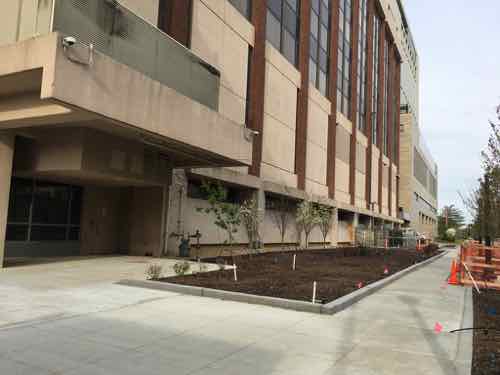


Schoenberg Pavilion was a building at Jewish Hospital, before the 1996 merger with Barnes Hospital — creating Barnes-Jewish Hospital. Today it looks very different than it did then. You cannot directly enter the building from the outdoors — only through the Center for Advanced Medicine (CAM) on the east or the newish Parkview Tower, on the west. The north side faces Forest Park Ave. and the south side is green space over an underground parking garage.
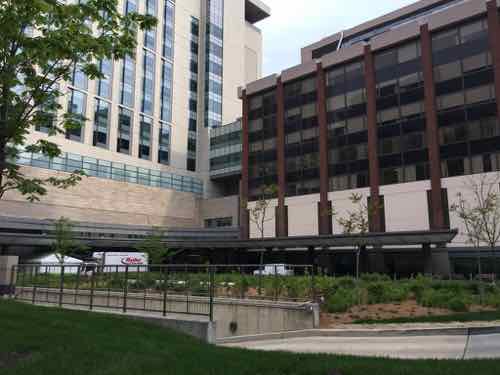
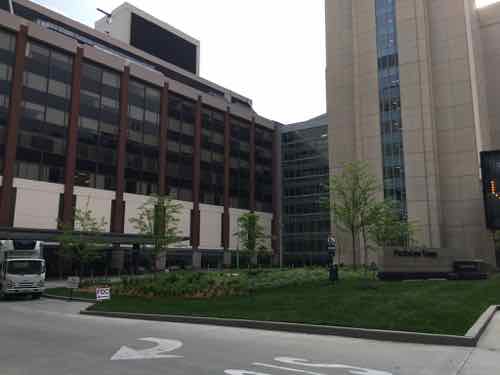
Inside the Schoenberg name is preset at the bank of elevators inside the 70s building.
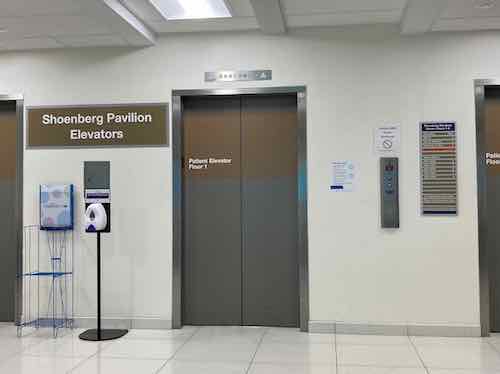
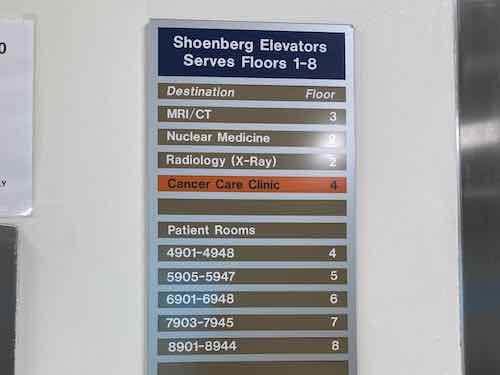
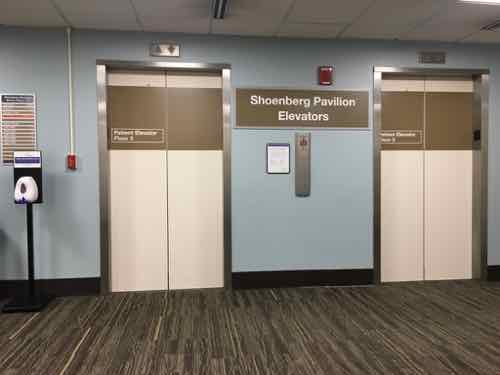
Inside the entry at the new Parkview Tower is a big sign with mottos from Barnes Hospital and Jewish Hospital.
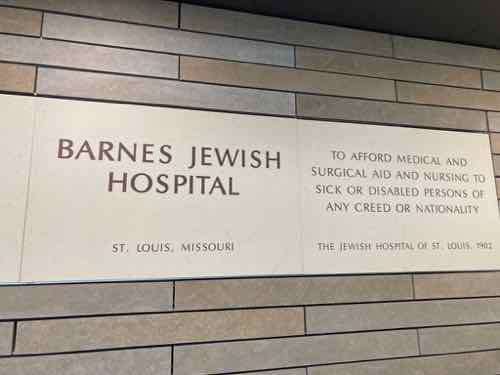
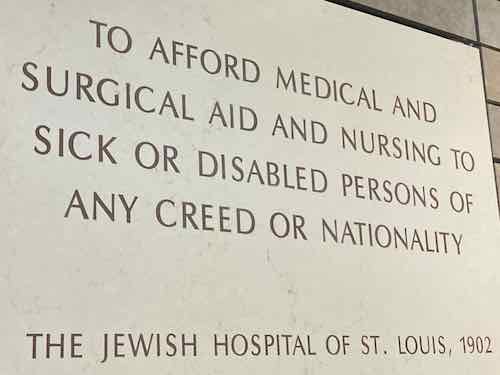
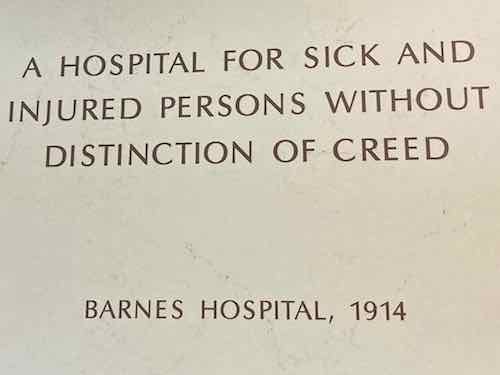
Jewish Hospital began a dozen years before Barnes Hospital, likely serving Jewish and n0n-Jewish patients. Though probably not black patients for many years.
And finally, in the main floor hallway connection the Center for Advanced Medicine to the Parkview Tower people from the history of Barnes & Jewish are highlighted in a beautiful display.
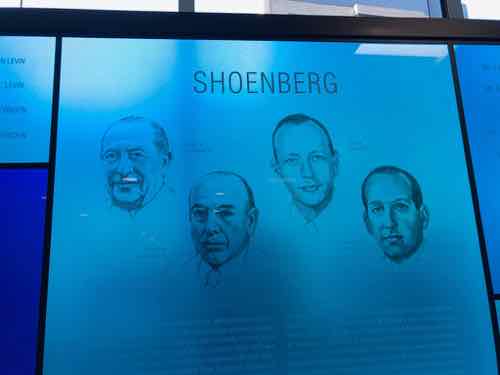
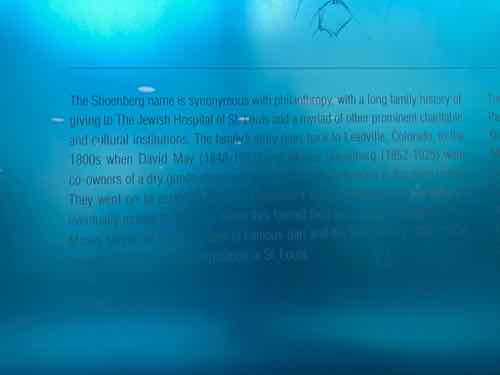
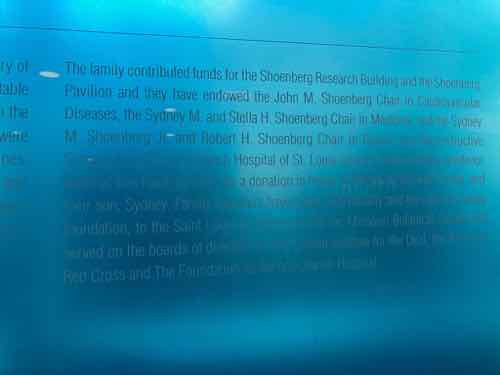
As I receive treatment at Washington University Medical School/BJC I’m thankful for the generosity of those who helped start and continue such a fine institution.
— Steve Patterson